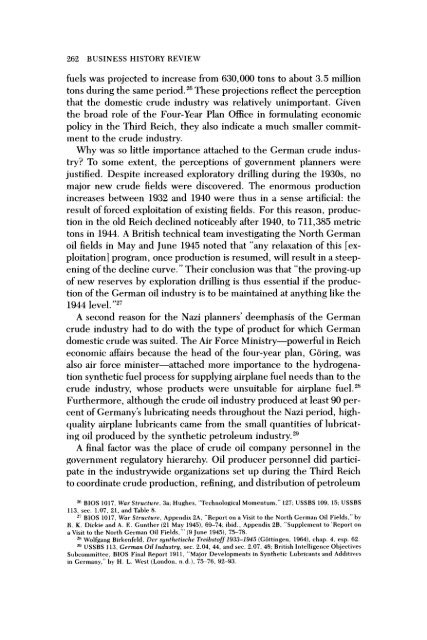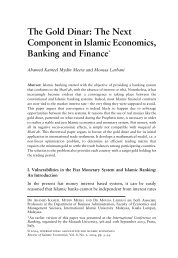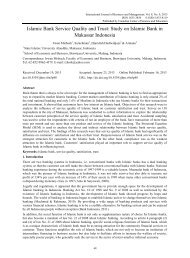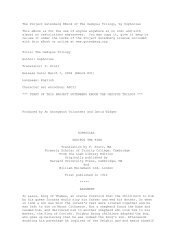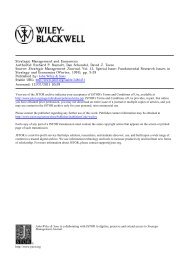The Oil Industry in Nazi Germany, 1936-1945
The Oil Industry in Nazi Germany, 1936-1945
The Oil Industry in Nazi Germany, 1936-1945
You also want an ePaper? Increase the reach of your titles
YUMPU automatically turns print PDFs into web optimized ePapers that Google loves.
262 BUSINESS HISTORY REVIEW<br />
fuels was projected to <strong>in</strong>crease from 630,000 tons to about 3.5 million<br />
tons dur<strong>in</strong>g the same period.26 <strong>The</strong>se projections reflect the perception<br />
that the domestic crude <strong>in</strong>dustry was relatively unimportant. Given<br />
the broad role of the Four-Year Plan Office <strong>in</strong> formulat<strong>in</strong>g economic<br />
policy <strong>in</strong> the Third Reich, they also <strong>in</strong>dicate a much smaller commit-<br />
ment to the crude <strong>in</strong>dustry.<br />
Why was so little importance attached to the German crude <strong>in</strong>dus-<br />
try? To some extent, the perceptions of government planners were<br />
justified. Despite <strong>in</strong>creased exploratory drill<strong>in</strong>g dur<strong>in</strong>g the 1930s, no<br />
major new crude fields were discovered. <strong>The</strong> enormous production<br />
<strong>in</strong>creases between 1932 and 1940 were thus <strong>in</strong> a sense artificial: the<br />
result of forced exploitation of exist<strong>in</strong>g fields. For this reason, produc-<br />
tion <strong>in</strong> the old Reich decl<strong>in</strong>ed noticeably after 1940, to 711,385 metric<br />
tons <strong>in</strong> 1944. A British technical team <strong>in</strong>vestigat<strong>in</strong>g the North German<br />
oil fields <strong>in</strong> May and June <strong>1945</strong> noted that "any relaxation of this [ex-<br />
ploitation] program, once production is resumed, will result <strong>in</strong> a steep-<br />
en<strong>in</strong>g of the decl<strong>in</strong>e curve." <strong>The</strong>ir conclusion was that "the prov<strong>in</strong>g-up<br />
of new reserves by exploration drill<strong>in</strong>g is thus essential if the produc-<br />
tion of the German oil <strong>in</strong>dustry is to be ma<strong>in</strong>ta<strong>in</strong>ed at anyth<strong>in</strong>g like the<br />
1944 level. "27<br />
A second reason for the <strong>Nazi</strong> planners' deemphasis of the German<br />
crude <strong>in</strong>dustry had to do with the type of product for which German<br />
domestic crude was suited. <strong>The</strong> Air Force M<strong>in</strong>istry-powerful <strong>in</strong> Reich<br />
economic affairs because the head of the four-year plan, G6r<strong>in</strong>g, was<br />
also air force m<strong>in</strong>ister-attached more importance to the hydrogena-<br />
tion synthetic fuel process for supply<strong>in</strong>g airplane fuel needs than to the<br />
crude <strong>in</strong>dustry, whose products were unsuitable for airplane fuel.28<br />
Furthermore, although the crude oil <strong>in</strong>dustry produced at least 90 per-<br />
cent of <strong>Germany</strong>'s lubricat<strong>in</strong>g needs throughout the <strong>Nazi</strong> period, high-<br />
quality airplane lubricants came from the small quantities of lubricat-<br />
<strong>in</strong>g oil produced by the synthetic petroleum <strong>in</strong>dustry.29<br />
A f<strong>in</strong>al factor was the place of crude oil company personnel <strong>in</strong> the<br />
government regulatory hierarchy. <strong>Oil</strong> producer personnel did partici-<br />
pate <strong>in</strong> the <strong>in</strong>dustrywide organizations set up dur<strong>in</strong>g the Third Reich<br />
to coord<strong>in</strong>ate crude production, ref<strong>in</strong><strong>in</strong>g, and distribution of petroleum<br />
26 BIOS 1017, War Structure, 3a; Hughes, "Technological Momentum," 127; USSBS 109, 15; USSBS<br />
113, sec. 1.07, 21, and Table 8.<br />
27 BIOS 1017, War Structure, Appendix 2A, "Report on a Visit to the North German <strong>Oil</strong> Fields," by<br />
R. K. Dickie and A. E. Gunther (21 May <strong>1945</strong>), 69-74; ibid., Appendix 2B, "Supplement to 'Report on<br />
a Visit to the North German <strong>Oil</strong> Fields,"' (9 June <strong>1945</strong>), 75-78.<br />
28 Wolfgang Birkenfeld, Der synthetische Treibstoff 1933-<strong>1945</strong> (G6tt<strong>in</strong>gen, 1964), chap. 4, esp. 62.<br />
29<br />
USSBS 113, German <strong>Oil</strong> <strong>Industry</strong>, sec. 2.04, 44, and sec. 2.07, 48; British Intelligence Objectives<br />
Subcommittee, BIOS F<strong>in</strong>al Report 1911, "Major Developments <strong>in</strong> Synthetic Lubricants and Additives<br />
<strong>in</strong> <strong>Germany</strong>," by H. L. West (London, n.d.), 75-76, 92-93.


